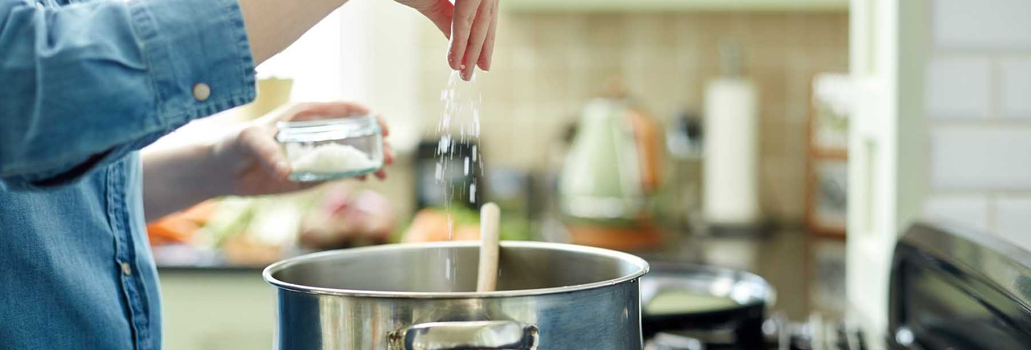
Revealed: Is there a better salt to sprinkle to help lower blood pressure?
Wanting to cut down on your sodium intake but finding it hard to put down the salt shaker? You’re not alone. Despite decades of evidence showing that having too much salt can lead to high blood pressure, a leading risk factor for heart disease, most Aussies are consuming much more than the daily recommended limit of 5g of salt. In fact, studies show that most Australians are eating roughly 9g of salt a day.
With 1 in 5 Australian adults living with high blood pressure, it’s time to make some simple dietary changes to reduce our sodium intake.
Could potassium-enriched salt be the answer? A new study looking into salt substitutes thinks it could be.
What is potassium-enriched salt?
Quite simply, it’s regular salt that has been enriched with potassium. It’s made by replacing some of the sodium chloride that makes up regular salt with potassium chloride. These products may be labelled as low-sodium salt, potassium salt, mineral salt, and sodium-reduced salt. Potassium-enriched salt can be used exactly as you would use regular salt, making it a pretty easy swap to make.
According to the World Health Organisation, potassium-enriched salt may be helpful in reducing sodium intake and increasing potassium, supporting lower blood pressure and reducing the risk of heart adisease. The WHO now recommends switching to lower-sodium salt substitutes, which offer a healthier alternative while still delivering the familiar taste of salt.
Why potassium?
Potassium is an essential mineral and electrolyte not produced by the body but can be sourced from a range of fruits, vegetables and legumes, as well as dairy and seafood.
Its main role is to maintain normal levels of fluid inside our cells. It relaxes our blood vessels and helps our bodies get rid of excess sodium, helping to maintain a healthy blood pressure. It also sends nerve signals and regulates muscle contractions.
High blood pressure? The DASH diet could be for you: https://www.sanitarium.com/au/health-nutrition/nutrition/whats-the-dash-diet
Should I make the switch?
Potassium-enriched salt is a good alternative for people who use large amounts of salt during cooking and take a liberal approach to the sprinkle at the table, but unfortunately it won’t help you to get a taste for less salty foods and it won’t reduce your overall intake of salt. For most of us, around 75% of our salt intake comes from packaged foods.
While potassium-enriched salt may be one way to start to help reduce your salt intake and lower your blood pressure, changes to your overall diet to further cut the salt will have the biggest impact. The good news is there are some really easy changes you can make to help you do this.
- More fruits and veggies: Where possible, try to replace some packaged foods with fresh fruit and vegetables including those high in potassium (such as avocados, sweet potato, potatoes, watermelon and bananas). As an example, if you’d normally cook with premade pasta sauce, try making your own veggie-packed version. You can control the salt levels and it’s a great use for any vegetables that might be looking a little sad in your crisper.
- Read the label: Packaged foods are incredibly convenient, so better understanding food labels can help you take control of your health and compare products before you purchase. When looking at the sodium content on the nutrition information panel, choose options with the smaller amount per 100g. As a guide, less than 120mg per 100g means that it is low in sodium, while foods with more than 600mg per 100g tend to be considered high in sodium.
- Reduce gradually: Try to gradually reduce the amount of salt you add to cooking or at the table over time. Just like learning a new skill, you can gradually re-train your taste buds to enjoy less salt. This way you will start to enjoy foods with less salt and can cut down on the need for large amounts of salt.
- Swap it: Rather than using salt for flavour, try using herbs and spices and even mushrooms for that umami taste in your meals. If you still really need to use salt, you could also try iodised salt which is normal salt that has been sprayed with potassium iodate.
What about pink Himalayan salt? Learn more about salt: https://www.sanitarium.com/au/health-nutrition/nutrition/food-in-focus-salt
Are there any risks with potassium-enriched salt?
In Australia, most adults are falling short of the recommended intake of potassium, so there is a low risk of having too much.
However, it is important to note some groups of people may need to limit potassium in their diet, particularly if their kidneys are not working well, or if they are taking medication that cause their bodies to hold on to potassium. For these people, it is important that they are guided by their healthcare provider about how much potassium they should have in their diet, as having too much potassium can be dangerous for their heart.
If you’re ready to start on your salt-reducing journey and don’t need to be mindful of too much potassium in your diet, you could give potassium-enriched salt a try, but the greatest impact will come from gradually reducing your intake of salt over time. This will gradually train your tastebuds to stop asking for it all together. You’ll be surprised at the other flavours you will start to pay more attention to and ultimately, stop craving salt altogether.

The latest nutrition advice, plus health and wellness tips delivered to your inbox monthly

